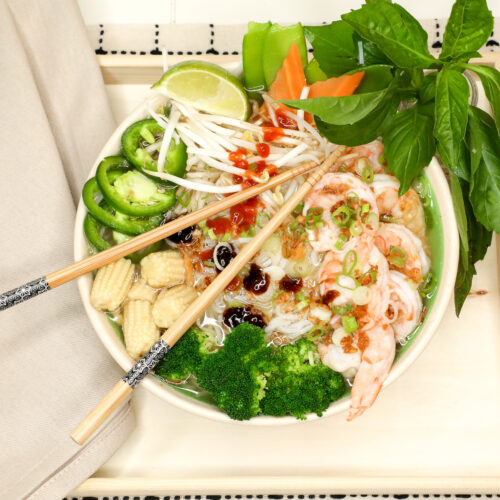Shrimp Pho
For the Broth:
- 2 Cups Shrimp Shells
- 3 Tbsp Fish Sauce
- 4 Cloves Garlic Minced
- 1-inch Piece of Ginger Sliced
- 2 Star Anise
- 2 Cinnamon Sticks
- 8 Cups Water
For the Vegetables:
- 1 Cup Broccoli Florets
- 1 Cup Carrots Thinly Sliced
- 1 Cup Snap Peas
- 1 Cup Baby Corn Cut into bite-sized pieces
For the Shrimp:
- 1 Lb Shrimp Peeled and deveined
- 1 Tbsp Paprika
- Salt and Pepper to Taste
- 2 Tbsp Oil For sautéing
For Garnishing:
- Sliced Jalapenos
- Lime Wedges
- Thai Basil Leaves
- Mung Bean Sprouts
- Chopped Green Onions
Step 1: Prepare the Broth
Char the AromaticsStart by heating a heavy-bottomed pot over medium-high heat. Add the onion and ginger, charring them until they are partially blackened on each side. Then, introduce the whole spices to the same pan and toast them until fragrant, as this process releases their essential oils and intensifies the broth's flavor profile. Next, lower the heat to medium and add the shrimp shells (note: use the shells from the shrimp used in step four) along with minced garlic, sautéing for an additional 2 minutes. Incorporate the shrimp shells and toast them until they turn a light pink and emit a seafood aroma, about 3-4 minutes. This step is vital as it enhances the umami flavor of the broth, creating a richer base for your dish. Once the garlic is fragrant, proceed to step two. Build the BrothPour in the fish sauce and 8 cups of water. The fish sauce adds depth and a savory note, while water acts as the base for your broth. Increase heat to high. SimmeringBring the mixture to a rolling boil, then reduce the heat to a gentle simmer. This slow cooking process allows the flavors to meld beautifully. Let it simmer for at least 2 hours; the longer you simmer, the more complex and flavorful your broth will become. Strain and ReserveAfter simmering, strain the broth through a fine mesh sieve into a bowl, discarding the solids. This leaves a clear, aromatic broth that serves as the essence of your pho.
Step 2: Cook the Noodles
Boil WaterIn another pot, bring water to a boil. This step must be done in a separate pot to prevent the starch from the noodles from clouding your broth. Cook the Rice NoodlesAdd the rice noodles and cook according to the package instructions (usually 5-7 minutes). Stir occasionally to prevent sticking. Cooking the noodles separately ensures they maintain their integrity and texture, which contributes to the overall mouthfeel of the dish. Drain and RinseOnce cooked, drain the noodles and rinse them under cold water. This halts the cooking process and removes excess starch, preventing the noodles from clumping together. Set them aside for later assembly.
Step 3: Prepare the Vegetables
Cut the VegetablesChop the broccoli into small florets, slice the carrots into thin rectangular pieces, and drain the baby corn. To prepare snap peas, use a sharp knife to trim off the stem ends of each snap pea. Some varieties of snap peas may have a string along the seam. If desired, you can gently pull the string away from the pod to enhance the eating experience. However, many people enjoy snap peas whole and find them tender enough to eat without string removal. Once prepared, the snap peas will add a delightful crunch and fresh sweetness to your shrimp Pho, perfectly complementing the other ingredients. Blanching Bring a pot of water to a boil and add the chopped vegetables. Blanch them for 2-3 minutes until their colors are vibrant and texture is tender-crisp. Blanching helps retain the color and nutritional value while also ensuring they are cooked perfectly without becoming mushy. Drain and Set AsideDrain the vegetables and immediately transfer them to an ice bath (a bowl of ice water). This locks in their bright colors and crisp texture, enhancing the visual appeal of your pho.
Step 4: Cook the Shrimp
Prepare the ShrimpUsing a paper towel dry the shrimp very well on each side. Season with salt, pepper, to taste and paprika for color. Heat the OilIn a large skillet, heat 2 tablespoons of oil over medium-high heat. A hot pan is key to achieving a beautiful sear on the shrimp. Sauté the ShrimpAdd the peeled and deveined shrimp in a single layer. Cook for 2-3 minutes on each side until they turn pink and opaque. This quick cooking method ensures the shrimp remain juicy and tender. Overcooking will result in a rubbery texture. Set AsideRemove the shrimp from the skillet and set aside. This keeps them warm while preparing the final assembly.
Step 5: Assemble the Pho
LayeringIn a large bowl, place a generous portion of the cooked rice noodles at the bottom. This forms the base of your dish and allows the flavors to build as you add other ingredients. Add the Vegetables and ShrimpNeatly arrange the blanched vegetables and sautéed shrimp on top of the noodles. This layering not only creates an attractive presentation but also allows each ingredient to shine. Pour the BrothCarefully ladle the hot seafood broth over the noodles, vegetables, and shrimp. The hot broth will warm the ingredients and meld the flavors beautifully. GarnishFinally, adorn your pho with sliced jalapeños for a kick, lime wedges for brightness, Thai basil leaves for aromatic freshness, mung bean sprouts for crunch, and chopped green onions for a burst of flavor. These garnishes add depth and complexity to each bite, elevating your pho experience.
